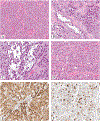FGFR1 fusions as a novel molecular driver in rhabdomyosarcoma
- PMID: 38607246
- PMCID: PMC11385681
- DOI: 10.1002/gcc.23232
FGFR1 fusions as a novel molecular driver in rhabdomyosarcoma
Abstract
The wide application of RNA sequencing in clinical practice has allowed the discovery of novel fusion genes, which have contributed to a refined molecular classification of rhabdomyosarcoma (RMS). Most fusions in RMS result in aberrant transcription factors, such as PAX3/7::FOXO1 in alveolar RMS (ARMS) and fusions involving VGLL2 or NCOA2 in infantile spindle cell RMS. However, recurrent fusions driving oncogenic kinase activation have not been reported in RMS. Triggered by an index case of an unclassified RMS (overlapping features between ARMS and sclerosing RMS) with a novel FGFR1::ANK1 fusion, we reviewed our molecular files for cases harboring FGFR1-related fusions. One additional case with an FGFR1::TACC1 fusion was identified in a tumor resembling embryonal RMS (ERMS) with anaplasia, but with no pathogenic variants in TP53 or DICER1 on germline testing. Both cases occurred in males, aged 7 and 24, and in the pelvis. The 2nd case also harbored additional alterations, including somatic TP53 and TET2 mutations. Two additional RMS cases (one unclassified, one ERMS) with FGFR1 overexpression but lacking FGFR1 fusions were identified by RNA sequencing. These two cases and the FGFR1::TACC1-positive case clustered together with the ERMS group by RNAseq. This is the first report of RMS harboring recurrent FGFR1 fusions. However, it remains unclear if FGFR1 fusions define a novel subset of RMS or alternatively, whether this alteration can sporadically drive the pathogenesis of known RMS subtypes, such as ERMS. Additional larger series with integrated genomic and epigenetic datasets are needed for better subclassification, as the resulting oncogenic kinase activation underscores the potential for targeted therapy.
Keywords: ANK1; FGFR1; TACC1; fusion; rhabdomyosarcoma.
© 2024 Wiley Periodicals LLC.
Conflict of interest statement
Figures



Similar articles
-
Rhabdomyosarcoma With EWSR1::NF2 Gene Fusion: A Case Report Potentially Expanding Its Genetic Spectrum.Genes Chromosomes Cancer. 2025 Jan;64(1):e70025. doi: 10.1002/gcc.70025. Genes Chromosomes Cancer. 2025. PMID: 39873201
-
DNA methylation patterns are influenced by Pax3::Foxo1 expression and developmental lineage in rhabdomyosarcoma tumours forming in genetically engineered mouse models.J Pathol. 2025 Mar;265(3):316-329. doi: 10.1002/path.6386. Epub 2025 Jan 15. J Pathol. 2025. PMID: 39812007 Free PMC article.
-
Alterations of RB1 gene in embryonal and alveolar rhabdomyosarcoma: special reference to utility of pRB immunoreactivity in differential diagnosis of rhabdomyosarcoma subtype.J Cancer Res Clin Oncol. 2008 Oct;134(10):1097-103. doi: 10.1007/s00432-008-0385-3. Epub 2008 Apr 2. J Cancer Res Clin Oncol. 2008. PMID: 18386058 Free PMC article.
-
The Black Book of Psychotropic Dosing and Monitoring.Psychopharmacol Bull. 2024 Jul 8;54(3):8-59. Psychopharmacol Bull. 2024. PMID: 38993656 Free PMC article. Review.
-
Signs and symptoms to determine if a patient presenting in primary care or hospital outpatient settings has COVID-19.Cochrane Database Syst Rev. 2022 May 20;5(5):CD013665. doi: 10.1002/14651858.CD013665.pub3. Cochrane Database Syst Rev. 2022. PMID: 35593186 Free PMC article.
Cited by
-
FGFR3::TACC3 fusions in head and neck carcinomas: a study of nine cases highlighting phenotypic heterogeneity, frequent HPV association, and a morphologically distinct subset in favor of a putative entity.Virchows Arch. 2025 Mar;486(3):499-510. doi: 10.1007/s00428-024-03940-3. Epub 2024 Oct 10. Virchows Arch. 2025. PMID: 39387893 Free PMC article.
References
-
- Berlanga P, Pierron G, Lacroix L, et al. The European MAPPYACTS Trial: Precision Medicine Program in Pediatric and Adolescent Patients with Recurrent Malignancies. Cancer Discovery. 2022;12(5):1266–1281. doi:10.1158/2159-8290.CD-21-1136 - DOI - PMC - PubMed
-
- Parsons DW, Janeway KA, Patton DR, et al. Actionable Tumor Alterations and Treatment Protocol Enrollment of Pediatric and Young Adult Patients With Refractory Cancers in the National Cancer Institute-Children’s Oncology Group Pediatric MATCH Trial. J Clin Oncol. 2022;40(20):2224–2234. doi:10.1200/JCO.21.02838 - DOI - PMC - PubMed
Publication types
MeSH terms
Substances
Grants and funding
LinkOut - more resources
Full Text Sources
Research Materials
Miscellaneous

